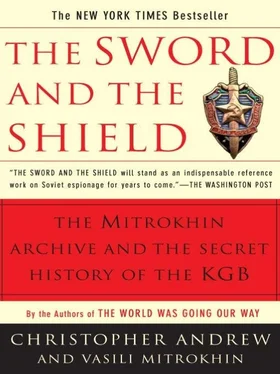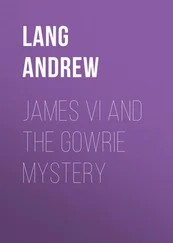The VOLUNTEER network expanded to include, in addition to MLAD, three other agents: ADEN, SERB and SILVER. 67Two of these were undoubtedly the two nuclear physicists contacted by Hall. Though their identities remain unknown, the Centre clearly regarded their intelligence as of the first importance. According to an SVR history, “the Volunteer group… were able to guarantee the transmittal to the Centre of supersecret information concerning the development of the American atomic bomb.” 68
In recognition of the VOLUNTEER group’s success, Fisher was awarded the Order of Red Banner in August 1949. 69A year later, however, his illegal residency was disrupted by the arrest of Julius and Ethel Rosenberg, for whom Lona Cohen had acted as courier. Both the Cohens were quickly withdrawn to Mexico, where they were sheltered for several months by the Soviet agents OREL (“Eagle”) and FISH—both members of the Spanish Communist Party in exile 70—before moving on to Moscow. The Cohens were to resurface a few years later, under the names Peter and Helen Kroger, as members of a new illegal residency in Britain. 71Hall’s career as a Soviet spy was also interrupted. In March 1951 he was questioned by an FBI team which was convinced that he was guilty of espionage but lacked the evidence for a prosecution. 72
Under his later alias “Rudolf Abel,” Fisher was to become one of the best-known of all Soviet illegals, whose career was publicized by the KGB as a prime example of the success and sophistication of its operations in the West during the Cold War. In reality, Fisher never came close to rivaling the achievements of his wartime predecessor, Iskhak Akhmerov. During eight years as illegal resident, he appears never to have identified, let alone recruited, a single promising potential agent to replace the VOLUNTEER network. 73Unlike Akhmerov, however, he did not have the active and enthusiastic assistance of a well-organized American Communist Party (CPUSA) to act as talent-spotters and assistants. Part of the reason for Fisher’s lack of success was the post-war decline and persecution of the CPUSA. 74
THE MOST IMPORTANT American agent recruited during the early Cold War, Aleksandr (“Sasha”) Grigoryevich Kopatzky, was a walk-in. Kopatzky had been born in the city of Surozh in Bryansk Oblast in 1923, 75and had served as a lieutenant in Soviet intelligence from August 1941 until he was wounded and captured by the Germans in December 1943. While in a German hospital he agreed to work for German intelligence. During the last two months of the war he served as an intelligence officer in General Andrei Vlasov’s anti-Soviet Russian Army of Liberation which fought the Red Army in alliance with the Wehrmacht. At the end of the war, Kopatzky was briefly imprisoned by the American authorities in the former concentration camp at Dachau. 76
Despite his service in the NKVD, Kopatzky’s anti-Soviet credentials seemed so well established that he was invited to join the American-supervised German intelligence service established in 1946 at Pullach, near Munich, by General Reinhard Gehlen, the former Wehrmacht intelligence chief on the eastern front. 77In 1948 Kopatzky further distanced himself from his Soviet past by marrying the daughter of a former SS officer, Eleonore Stirner, who had been briefly imprisoned for her activities in the Hitler Youth. Eleonore later recalled that her husband “drank a lot of vodka. He kissed ladies’ hands… He was very punctual, shined his shoes, did his gymnastics in the morning, had a neat haircut, short hair all his life. And he was a very good shot. Sasha liked to hunt and talked of hunting tigers in Siberia with his father.” Many years later, after Sasha’s death, it suddenly occurred to Eleonore, while watching a televised adaptation of a John Le Carré novel, that her husband might have married her to improve his cover. That realization, she says, “came like a mountain of bricks on me.” 78By their wedding day Kopatzky was probably already planning to renew contact with Soviet intelligence.
The SVR still regards the Kopatzky case as extremely sensitive. It insisted as recently as 1997 that no file exists which suggests that Kopatzky, under any of his aliases, ever engaged in “collaboration… with Soviet intelligence.” 79Mitrokhin, however, was able to take detailed notes from the bulky file which the SVR claims does not exist. The file reveals that in 1949 Kopatzky visited the Soviet military mission in Baden-Baden, and was secretly transported to East Berlin where he agreed to become a Soviet agent. 80Soon afterwards, he infiltrated the anti-Soviet émigré organization Union of the Struggle for Liberation of the Peoples of Russia (SBONR), based in Munich, which had close links with the CIA. In 1951, doubtless to his Soviet controllers’ delight, he was recruited by the CIA station in West Berlin as “principal agent.” 81Successively codenamed ERWIN, HERBERT and RICHARD by the Centre, Kopatzky received a monthly salary of 500 marks in addition to his income from the CIA. Among his earliest successes was, on November 5, 1951, to get one of his fellow CIA agents, the Estonian Vladimir Kivi (wrongly described in Kopatzky’s file as an “American intelligence chief”), drunk, transport him to East Berlin and hand him over to Soviet intelligence. 82Though Kopatzky was not a CIA staff officer and never worked at Agency headquarters, he did enormous damage to Agency operations in Germany for more than a decade. 83According to his file, no fewer than twenty-three KGB legal operational officers and one illegal “met and worked with him”—a certain indication of how highly the Centre rated him. 84
————
THROUGHOUT THE COLD WAR, Soviet intelligence regarded the United States as its “main adversary.” In second place at the beginning of the Cold War was the United States’s closest ally, the United Kingdom. In third position came France. 85Before the Second World War, France had been a major base for NKVD foreign operations. Her crushing defeat in June 1940, however, followed by the German occupation of northern France, the establishment of the collaborationist Vichy regime in the south (later also occupied by the Germans) and Hitler’s invasion of the Soviet Union in June 1941 drastically reduced the scope for Soviet penetration. The NKGB did, however, establish a strong presence within Communist sections of the French Resistance.
There were two main groups of Soviet agents in wartime France: one in Paris of about fifty Communists and fellow travelers headed by LEMOINE (transliterated into the Cyrillic alphabet as LEMONYE), and another of over twenty-five headed by HENRI, based on Toulouse, with, from 1941, a subgroup in Paris. According to KGB records, the LEMOINE group, most of whom believed they were working for the Communist Party rather than the NKGB, “was disbanded because of treachery.” Though six members of the HENRI group (KLOD, LUCIEN, MORIS, ROBERT and ZHANETTA) were caught and shot by the Germans, the core of the group survived. 86
At the end of the war Soviet intelligence had much greater freedom of action in France than in either the United States or Britain. The Parti Communiste Français (PCF) publicly congratulated itself on its undeniably heroic role in the wartime Resistance, proudly termed itself le parti des fusillés (“the party of the shot”), and greatly inflated the numbers of its fallen heroes. From August 1944, when General de Gaulle invited the PCF to join the Provisional Government, there were Communist ministers for the first time in French history. According to an opinion poll in May 1945, 57 percent of the population thought that the defeat of Germany was due principally to the Soviet Union (20 percent gave the most credit to the United States, 12 percent to Britain). In the elections of October 1945 the PCF, with 26 percent of the vote, emerged as the largest party in France. By the end of the year it had almost 800,000 members. Though support for the PCF had almost peaked, there were many who hoped—or feared, particularly after de Gaulle’s resignation early in 1946—that France was on the road to becoming a Communist-controlled “people’s democracy.” One socialist minister privately complained, “How many senior civil servants, even at the very top, are backing Communism to win!” 87
Читать дальше











